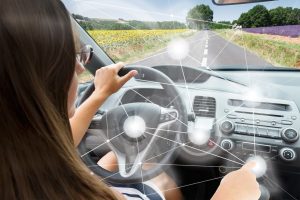In 2013, on the streets of Parma, Italy, an autonomous vehicle successfully navigated a route on a public roadway without a driver. The course was relatively short, but, it did include a series of complex traffic scenarios, roundabouts, merging traffic lanes, lights and pedestrian crossings. This was accomplished using a series of 3D imaging techniques built into the car.
Google’s driverless cars may be a vision of what we all will be driving, or not driving, in the future. For now, car owners will have to make do with sensors that merely assist in driving, rather than doing it all for them.
Google’s cars use a l aser range finder, as well as video cameras and radar sensors, to pilot the vehicle. The same laser range finding or time-of-flight (TOF) technology is being developed and tested by many auto manufacturers as one of the potential sensing techniques for driver assistance. Toyota’s Central research and development labs in Japan have developed a prototype TOF sensor with a 100m range that could be used for obstacle avoidance, pedestrian detection, and lane detection.
aser range finder, as well as video cameras and radar sensors, to pilot the vehicle. The same laser range finding or time-of-flight (TOF) technology is being developed and tested by many auto manufacturers as one of the potential sensing techniques for driver assistance. Toyota’s Central research and development labs in Japan have developed a prototype TOF sensor with a 100m range that could be used for obstacle avoidance, pedestrian detection, and lane detection.
Time-of-flight is a 3D imaging technique that creates a depth map of a scene. By illuminating the scene, it captures the light reflected from objects and measures the round-trip time, (TOF) which is proportional to the distance. In this way, each pixel provides a measurement of distance.
These sensors won’t find their way into cars for another few years – Jochen Penne, director of business development at Pmd Technologies, suggests five years due to the length of the innovation cycle in the automotive sector – but there are TOF cameras already in use in industry, albeit to a limited extent compared to other 3D imaging techniques like laser triangulation.
Smart sensors for parking and other uses are now integrated into many newer model cars. Automakers are developing various small, low-cost vision sensors for improved driver assistance, such as time-of-flight 3D sensors.
As technology improves, UKA is here to design a precision lens to conform to the specifications for 3D imaging necessary your specific camera.
During the experiment on the roads around Parma, Dr. Broggi, director of VisLab, said the hardest traffic scenario to navigate were the roundabouts. The BRAiVE vehicle could tackle smaller roundabouts, although Dr Broggi added that the car would have been unable to pilot itself around larger, multi-lane versions.
“A roundabout is a huge problem. A roundabout could be very large, could have a large radius with up to three lanes,” Dr. Broggi commented. “It depends on the angle of approach,” he said. To tackle larger roundabouts, the car would need 180° vision on its left-hand side. The design used was only equipped with 110° vision.
Universe Kogaku designs and manufactures optical lenses for 3D imaging technique, security, high tech and electronic applications. We stock 1000’s of standard lens assemblies and can custom design a solution for scanners, CCTV, CCD/CMOS, medical imaging, surveillance systems, machine vision and night vision systems.